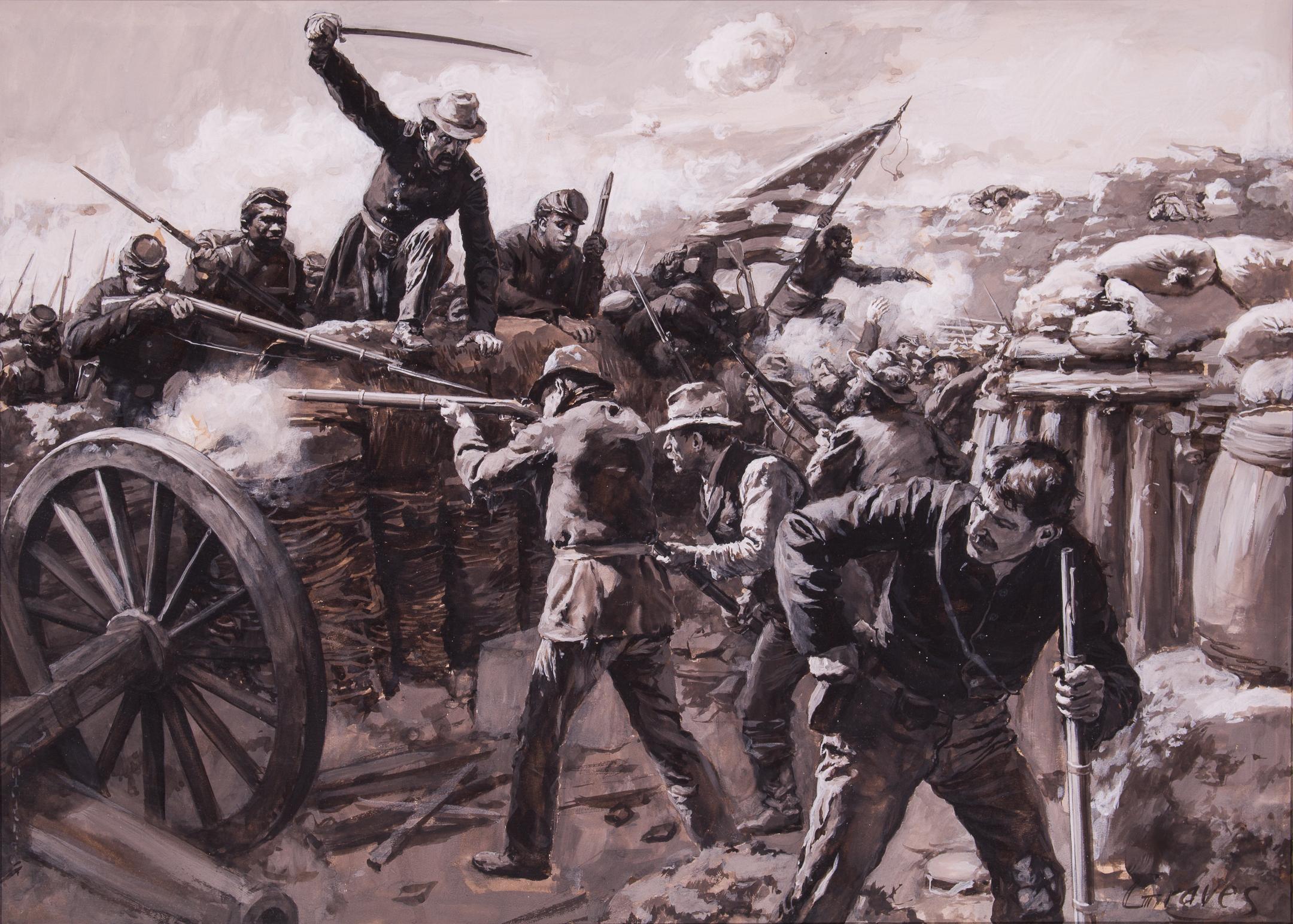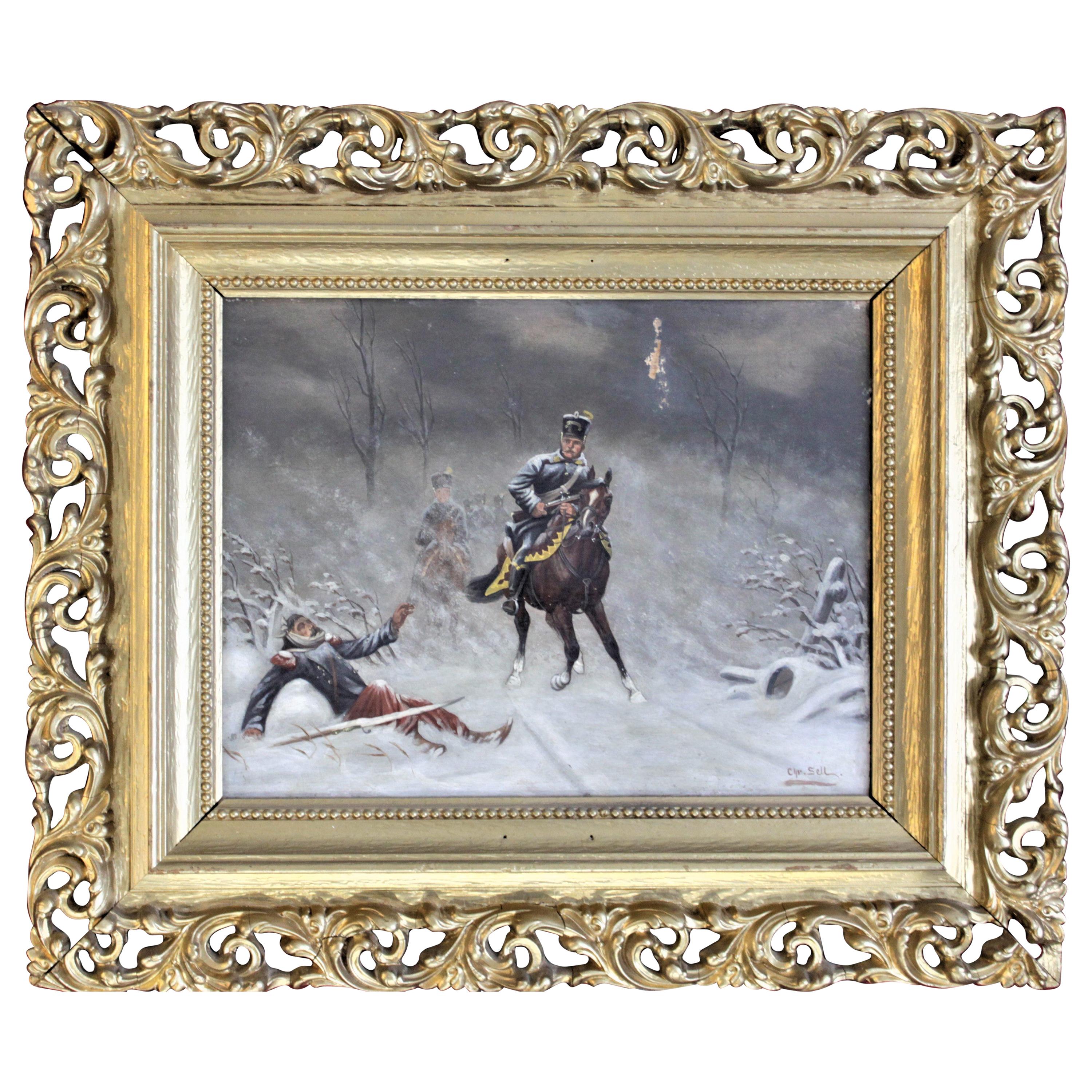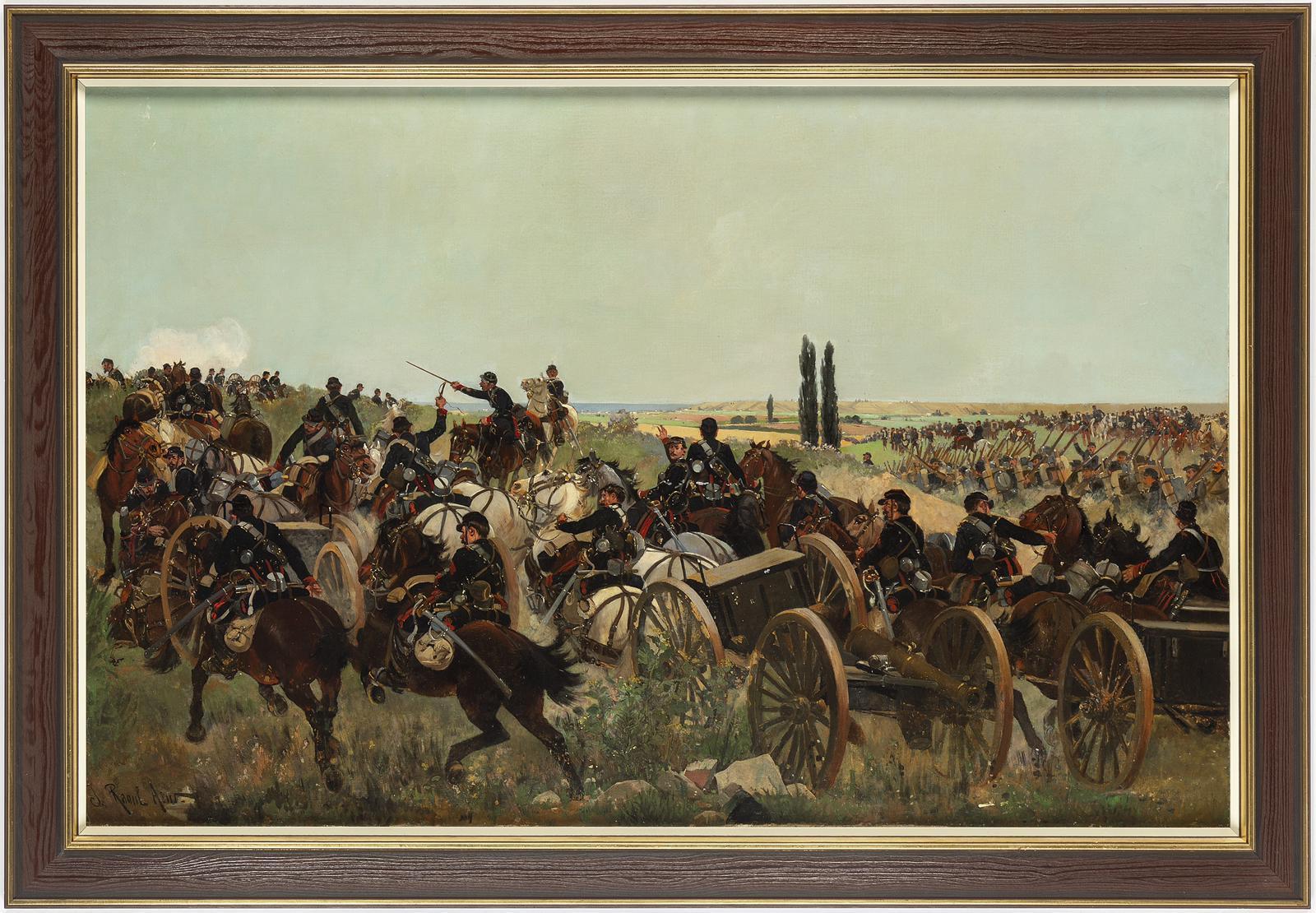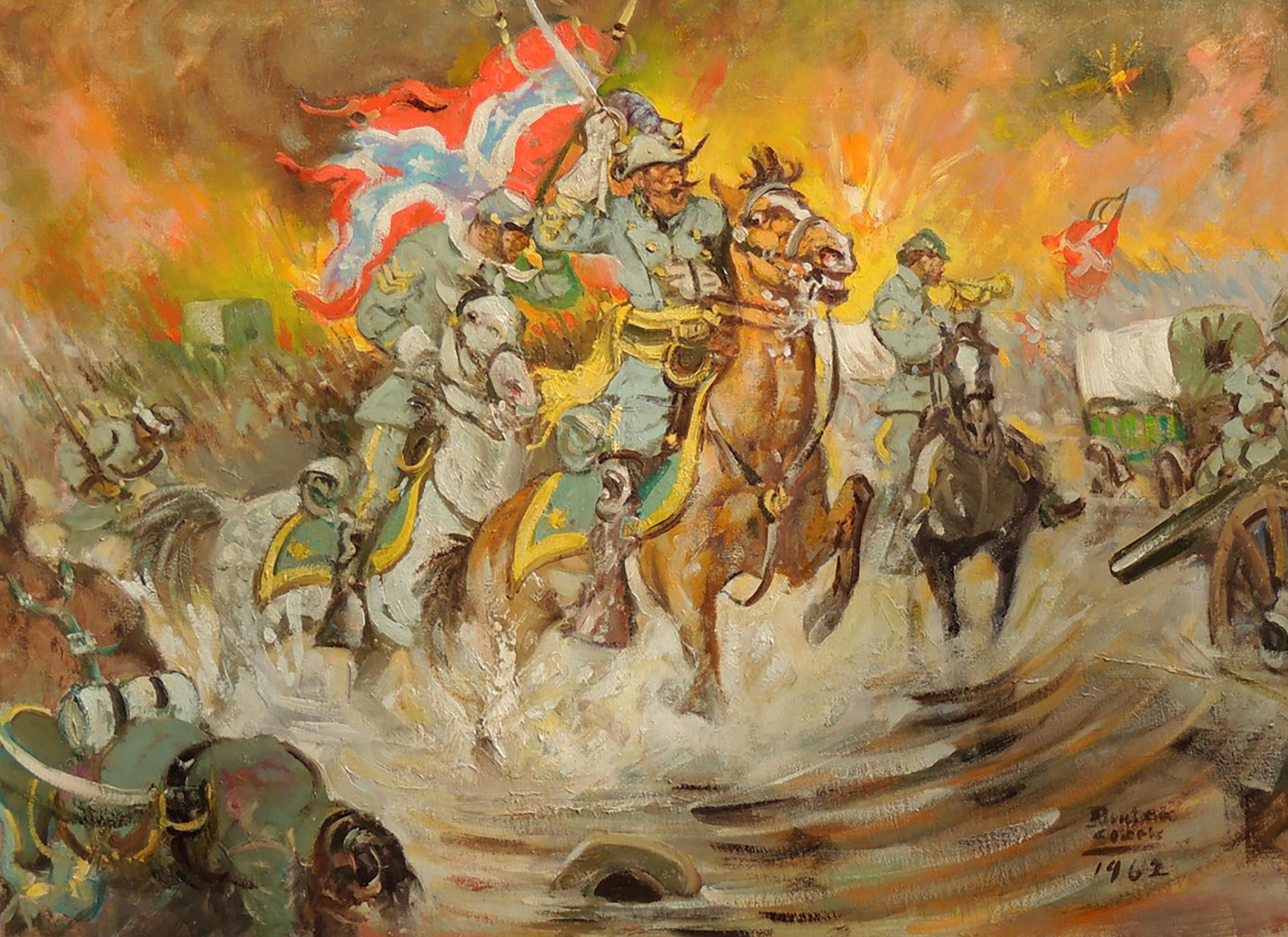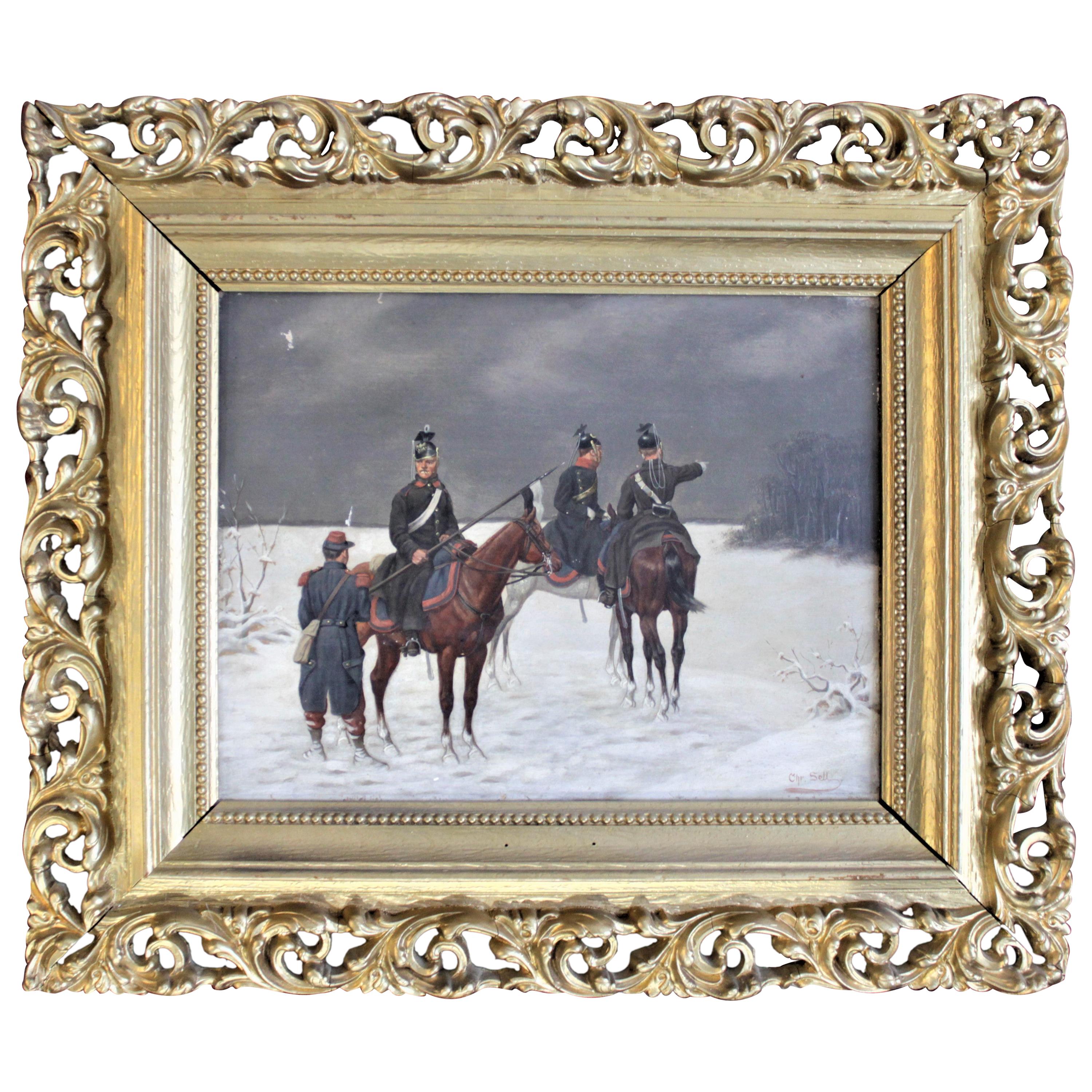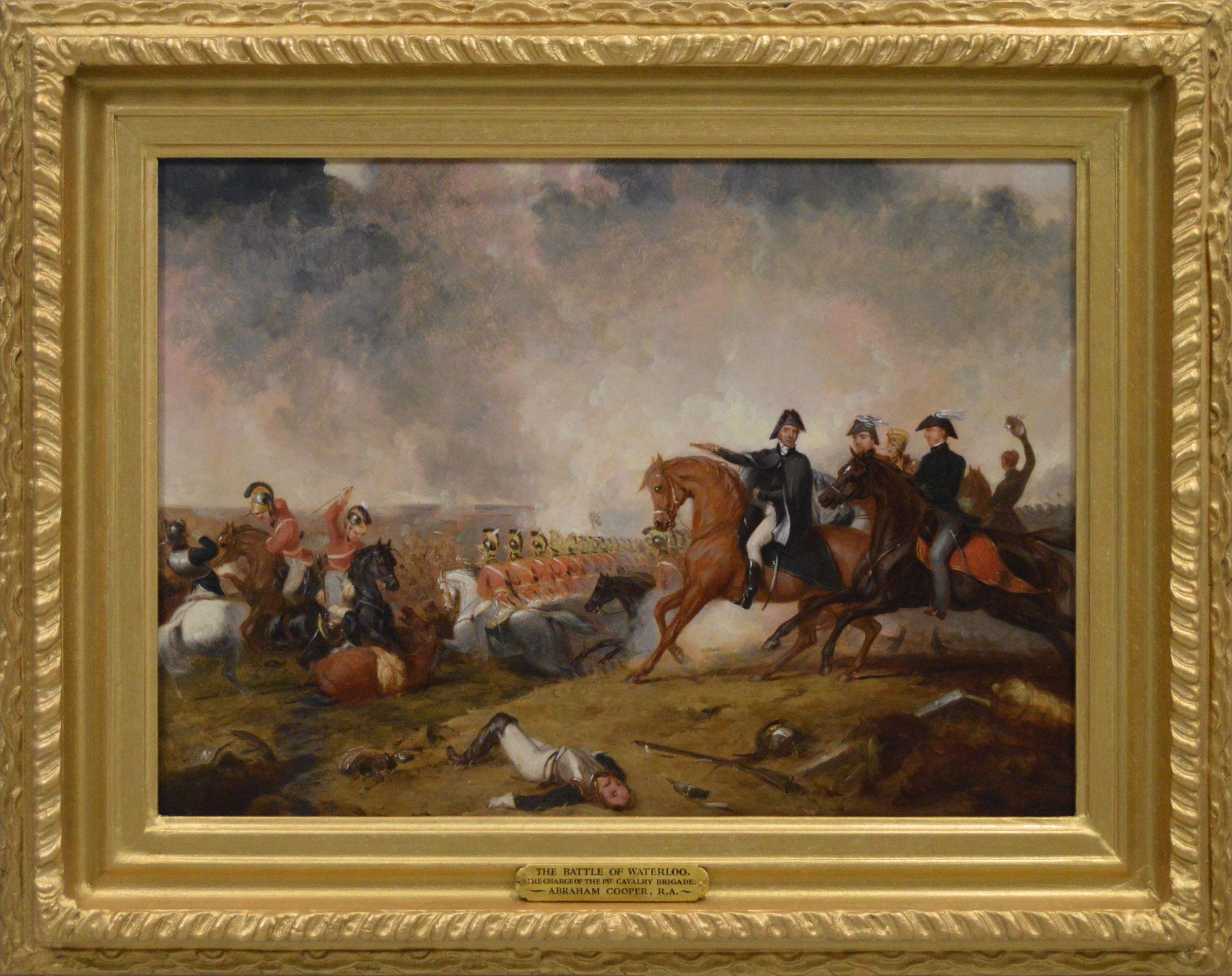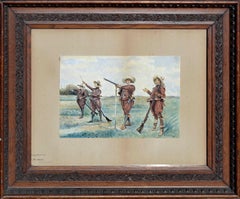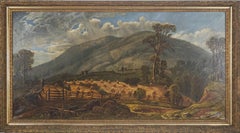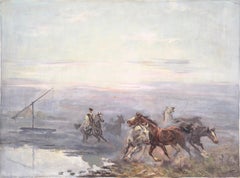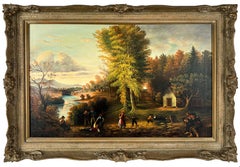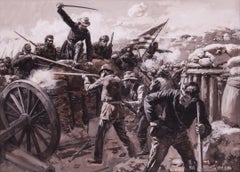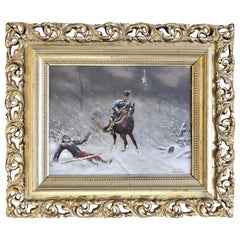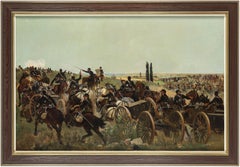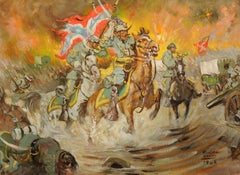Items Similar to 1880s Figurative Sackett's Calvary Charge of the 9th New York Volunteers
Want more images or videos?
Request additional images or videos from the seller
1 of 9
Unknown1880s Figurative Sackett's Calvary Charge of the 9th New York Volunteersc.1880s
c.1880s
$4,400
$5,50020% Off
£3,292.17
£4,115.2120% Off
€3,820.82
€4,776.0320% Off
CA$6,126.46
CA$7,658.0720% Off
A$6,890.91
A$8,613.6320% Off
CHF 3,574.16
CHF 4,467.7020% Off
MX$83,591.72
MX$104,489.6420% Off
NOK 45,318.27
NOK 56,647.8320% Off
SEK 42,647.03
SEK 53,308.7820% Off
DKK 28,504.43
DKK 35,630.5320% Off
Shipping
Retrieving quote...The 1stDibs Promise:
Authenticity Guarantee,
Money-Back Guarantee,
24-Hour Cancellation
About the Item
Late 19th century figurative painting of the battle of Trevilians Station and of the wounding of Colonel Sackett June 11, 1864. Oil on canvas in giltwood frame. Signed or notated indistinctly lower right. Image, 20.25"H x 36.25"W.
Military History Prior to 1865
The 9th New York Cavalry contained two companies from Cattaraugus County. It was mustered into the service October 1, 1861 and, until mustered out in July, 1865, lost 619 officers and men out of a total enlistment of a little less than two thousand. It participated in many battles and skirmishes and lost its colonel, William Sackett, who was killed at Trevilian Station, Virginia, on June 11, 1864.
From the Albany Evening Journal, July 20, 1864:
Another name is added to the list of hero martyrs who have fallen in the service of their country. Col. WILLIAM SACKETT, of the Ninth New-York Cavalry, (son of Hon. W.A. SACKETT,) was mortally wounded in the engagement, under Gen. SHERIDAN, at Pavillion Station, Va., and died on the 14th ult. As he was left behind, the sad intelligence of his decease has but just been received.
Col. SACKETT had seen much service. He entered the army on the 22d of April, 1861, was appointed Major of the Ninth New-York Cavalry in October of the same year, was promoted to Lieutenant-Colonelcy in August, 1862, and in March, 1863, became commander of the regiment. He was with Gen. MCCLEELAN in the Peninsula campaign, was in all the cavalry actions of the campaign which followed, was with the army in its advance after the battle of Antietam, and in almost constant conflict with the enemy until after the battle of Fredericksburgh. He participated in most of the cavalry engagements under Gen. HOOKER's command, was in all the principal cavalry actions during LEE's invasion of Maryland and Pennsylvania in 1863, and was among the first engaged in the terrible conflict at Gettysburgh, where he performed distinguished service in holding a rebel brigade in check a long time while our forces were getting into position on the crest of the hill. He was active in the cavalry skirmishes which ensued in the latter part of the Summer.
During the present campaign he was with Gen. SHERIDAN in all his brilliant expeditions up to the time when he fell. He died while leading a charge against the enemies of his country -- died, as he wished to die, doing his whole duty. He was brave, he was generous, he was unflinchingly faithful to the cause of the Union. He loved the old flag with a love that was stronger than life, and esteemed it glorious to fall in its defense. He was born in Seneca Falls, and was 25 years of age.
When the great civil war broke out [William Sackett] was practicing law at Albany, N. Y., having a short time previous been admitted to the bar. In December, 1861, he was commissioned Major of the 9th Regiment of New York Cavalry, and taking the field served with credit in several engagements in which that command participated. On June 27, 1862, his immediate superior, Lieutenant- Colonel Hyde, resigned and three days later Major Sackett was commissioned to fill the vacancy. On the 30th of the following May he was advanced to the Colonelcy of his regiment, with rank from March 15, 1863.
It is stated in "Battles and Leaders of the Civil War" that the cavalry pickets commanded by Colonel Sackett fired the first shot at the battle of Gettysburg. He subsequently led his command, in a gallant manner, in numerous engagements, including the battle of Trevilians Station, fought June 10, 1864. There he received a mortal wound and died inside of the enemy's lines some three days later. The report that he had been severely wounded and was in the hands of the enemy soon reached his wife, who immediately determined to make an effort to reach and care for him, not knowing that he was already dead when the report reached her. The following correspondence, copied from Official Records published by the War Department, tells in most emphatic terms of her devotion.
City Point, Va., July 7, 1864.
General R. E. Lee, Commanding Confederate Army,
Mrs. Sackett, the wife of Colonel William Sackett, who was wounded on the 11th of June, near Trevilians Station, Va., is here in deep distress and feeling great anxiety to learn the fate of her husband. Colonel Sackett was left at a house some two miles and a half from the station, in charge of Surgeon Ray, U. S. Volunteers. If you can let me know the fate and present whereabouts of Colonel Sackett you will alleviate the anxiety of his wife and family. I will add that it always has and always will afford me pleasure to relieve the minds of persons in the south, having friends in the north, either by forwarding open letters to them or by ascertaining where they are, their condition, etc. Mrs. Sackett is very desirous that I should ask you for permission to visit her husband if he is still alive. She would not expect to go through Richmond, but would start from Alexandria, by private conveyance, if authorized to do so.
U. S. GRANT,
Lieut.-General.
Headquarters, Army of Northern Virginia, July 10, 1864.
Lieut-General U. S. Grant, Commanding U. S. Armies,
General:—Your letters with reference to Mrs. Wadsworth and Mrs. Sackett are received. I have directed inquiries to be made for the effects of the late General Wadsworth, and if they can be found will take great pleasure in restoring them to his widow. I have also taken measures to ascertain the condition and whereabouts of Colonel Sackett, and the information you ask shall be conveyed to you as soon as it can be ascertained. I regret, however, that it is not in my power to permit Mrs. Sackett to visit her husband at this time. The reasons that induce me to withhold my consent are applicable to the route she proposes to take, as indicated by you.
Very respectfully, your obedient servant,
R. E. LEE, General.
- Creation Year:c.1880s
- Dimensions:Height: 25.75 in (65.41 cm)Width: 41.75 in (106.05 cm)Depth: 1.25 in (3.18 cm)
- Medium:
- Movement & Style:
- Period:
- Condition:Professionally in-painted and restored.
- Gallery Location:Soquel, CA
- Reference Number:Seller: JT-j49921stDibs: LU5422797931
About the Seller
5.0
Platinum Seller
Premium sellers with a 4.7+ rating and 24-hour response times
Established in 1986
1stDibs seller since 2014
2,944 sales on 1stDibs
Typical response time: <1 hour
- ShippingRetrieving quote...Shipping from: Soquel, CA
- Return Policy
Authenticity Guarantee
In the unlikely event there’s an issue with an item’s authenticity, contact us within 1 year for a full refund. DetailsMoney-Back Guarantee
If your item is not as described, is damaged in transit, or does not arrive, contact us within 7 days for a full refund. Details24-Hour Cancellation
You have a 24-hour grace period in which to reconsider your purchase, with no questions asked.Vetted Professional Sellers
Our world-class sellers must adhere to strict standards for service and quality, maintaining the integrity of our listings.Price-Match Guarantee
If you find that a seller listed the same item for a lower price elsewhere, we’ll match it.Trusted Global Delivery
Our best-in-class carrier network provides specialized shipping options worldwide, including custom delivery.More From This Seller
View All"Arquebusiers En Manoeuvre", After Marchetti
Located in Soquel, CA
Figurative landscape of four infantrymen in formation with their long arquebus guns by Adolphe Ancker (Dutch, 19th Century), after Marchetti. Signed and dated "Adolph Ancker 1888" lo...
Category
1880s American Impressionist Figurative Drawings and Watercolors
Materials
Watercolor, Pencil, Paper
Original Late 19th Century Oil Painting of Upstate New York Landscape
Located in Soquel, CA
Late 19th Century Upstate New York Oil Painting Landscape by Frances B. Clark
Moody rural Hudson River School style painting of Upstate ...
Category
1880s Post-Impressionist Landscape Paintings
Materials
Oil, Stretcher Bars, Linen
Rounding Up the Horses - Caballero
Located in Soquel, CA
Dynamic depiction of a rider with a group of horses near the water's edge. Several horses are in for foreground, running towards the viewer. Just behind them, a rider in American col...
Category
Mid-20th Century Impressionist Landscape Paintings
Materials
Canvas, Oil
Evening Time New York Hudson River School Scene Oil on Canvas Ornate Frame
Located in Soquel, CA
Evening Time Hudson River School Style Scene Oil on Canvas
European style painting of the Hudson river Valley School by B. Czerniawski (Polish/Ame...
Category
1860s American Impressionist Figurative Paintings
Materials
Canvas, Oil
$1,480 Sale Price
20% Off
"Full Cry" - Mid Century Horse Hunt Figurative Landscape
By John Frederick Herring Sr.
Located in Soquel, CA
A dynamic mid 20th century copy of a lithograph that depicts Englishmen on horseback giving chase with a pack of beagle-type dogs running in the background. by John Frederick Herring...
Category
1960s Romantic Landscape Prints
Materials
Offset, Paper
$396 Sale Price
20% Off
Early 20th Century Old Civil War Soldier Portrait of Honor
Located in Soquel, CA
Wonderful turn of the century oil portrait of old civil war soldier circa 1900, by an unknown artist. Soldier is depicted wearing the Medal of Honor...
Category
1890s American Impressionist Portrait Paintings
Materials
Oil, Cardboard
You May Also Like
Colonel Bates Leads the 30th Colored Infantry at the Battle of the Crater
By Abbott Fuller Graves
Located in Costa Mesa, CA
Colonel Bates Leads the 30th Colored Infantry at the Battle of the Crater
Watercolor on Paper Circa 1903
15 ½ x 21 ½ Inches 25 ½ x 33 ½ Inches Framed
LR: Graves
This rare portrait of African American troops serving in battle during the Civil War depicts the 30th United States Colored Infantry at the Battle of the Crater, at Petersburg, Virginia. The regiment was composed of African American enlisted men commanded by white officers and was authorized by the Bureau of Colored Troops which was created by the United States War Department on May 22, 1863.
The Battle of the Crater, July 30th, 1864, was part of the Siege of Petersburg, fought between the Confederate Army of Northern Virginia, commanded by General Robert E. Lee and the Union Army of the Potomac, commanded by Maj. Gen. George G. Meade (under the direct supervision of the general-in-chief, Lt. Gen. Ulysses S. Grant).
At the top of the painting, Colonel Delevan Bates raises his saber to lead the charge of the 30th United States Colored Infantry. Bates was promoted to this command just prior to this battle, having served with distinction in the 121st New York Infantry at the Battles of Fredericksburg, Chancellorsville and Gettysburg. Though the Battle of the Crater would eventually be won by the Confederacy, it was here that Bates and 23 other troops would be award the United States highest award for bravery during combat, the Medal of Honor.
After weeks of preparation, on July 30, Union forces exploded a mine in Maj. Gen. Ambrose E. Burnside's IX Corps sector, blowing a gap in the Confederate defenses of Petersburg, Virginia. From this propitious beginning, everything deteriorated rapidly for the Union attackers. Unit after unit charged into and around the crater, where soldiers milled in confusion. Grant considered the assault "the saddest affair I have witnessed in this war." The Confederates quickly recovered and launched several counterattacks led by Brig. Gen. William Mahone. The breach was sealed off, and Union forces were repulsed with severe casualties. Brig. Gen. Edward Ferrero's division of black soldiers...
Category
Early 1900s American Realist Figurative Paintings
Materials
Paper, Watercolor
Original Christian Sell Oil Painting on Panel of Soldiers in Battle
By Christien Sell
Located in Hamilton, Ontario
This well executed original oil painting on wood panel was done by Christian Sell the Younger in circa 1880 in his realistic style. The painting portrays soldiers on horseback in the...
Category
Antique Late 19th Century German Early Victorian Paintings
Materials
Wood
The French-Prussian War - Oil on Canvas by Raoul Arus - Late 19th Century
Located in Roma, IT
The French-Prussian War is an original modern artwork realized by the French painter Raoul-Joseph Arus in the last decades of the XIX Century.
Original Oil painting on Canvas.
Hand...
Category
Late 19th Century Figurative Paintings
Materials
Canvas, Oil
Charge, General Jeb Stuart Leading Charge in Civil War
By Benton Clark
Located in Fort Washington, PA
Medium: Oil Painting
Signature: Signed Lower Right
Category
20th Century Figurative Paintings
Materials
Oil
Original Christian Sell Oil Painting on Panel of Soldiers in Battle
By Christien Sell
Located in Hamilton, Ontario
This well executed original oil painting on wood panel was done by Christian Sell the Younger in circa 1880 in his realistic style. The painting portrays soldiers standing and on hor...
Category
Antique Late 19th Century German Early Victorian Paintings
Materials
Wood
19th Century Historical military oil painting of Wellington at Waterloo
By Abraham Cooper
Located in Nr Broadway, Worcestershire
Abraham Cooper RA
British, (1787-1868)
The charge of the 1st Cavalry Brigade
Oil on panel
Image size: 11.25 inches x 15.5 inches
Size including frame: 16.5 inches x 20.75 inches
Pro...
Category
19th Century Figurative Paintings
Materials
Oil, Panel
